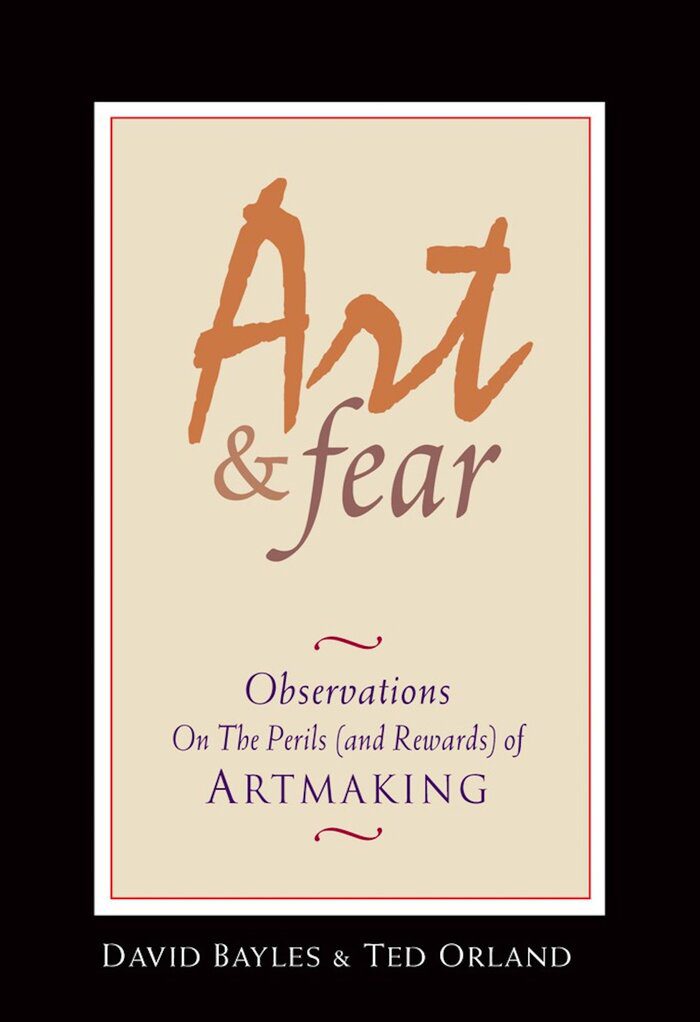In Art & Fear: Observations on the Perils (and Rewards) of Artmaking, Artists David Bayles & Ted Orland explores the way art gets made, the reasons it often doesn’t get made, and the nature of the difficulties that cause so many artists to give up along the way. Art & Fear is a book written by artists, for artists – it’s about what it feels like when artists sit down at their easel or keyboard, in their studio or performance space, trying to do the work they need to do. Their insights and observations, drawn from personal experience, provide an incisive view into the world of art as it is experienced by artmakers themselves.
Life is short, art long, opportunity fleeting, experience treacherous, judgment difficult. — Hippocrates (460-400 B.C.)
Making art can feel dangerous and revealing. Making art is dangerous and revealing. Making art precipitates self-doubt, stirring deep waters that lay between what you know you should be, and what you fear you might be.
More often, though, fears rise in those entirely appropriate (and frequently recurring) moments when vision races ahead of execution.
Making art now means working in the face of uncertainty; it means living with doubt and contradiction, doing something no one much cares whether you do, and for which there may be neither audience nor reward. Making the work you want to make means setting aside these doubts so that you may see clearly what you have done, and thereby see where to go next. Making the work you want to make means finding nourishment within the work itself. This is not the Age of Faith, Truth, and Certainty.
Something about making art has to do with overcoming things, giving us a clear opportunity for doing things in ways we have always known we should do them.
Make Art you care about
One of the basic and difficult lessons every artist must learn is that even the failed pieces are essential. X-rays of famous paintings reveal that even master artists sometimes made basic mid-course corrections (or deleted really dumb mistakes) by overpainting the still-wet canvas.
The point is that you learn how to make your work by making your work, and a great many of the pieces you make along the way will never stand out as finished art. The best you can do is make art you care about — and lots of it!
The best you can do is make art you care about — and lots of it!
On Quitting
THOSE WHO WOULD MAKE ART might well begin by reflecting on the fate of those who preceded them: most who began, quit.
It’s a genuine tragedy. Worse yet, it’s an unnecessary tragedy. After all, artists who continue and artists who quit share an immense field of common emotional ground. (Viewed from the outside, in fact, they’re indistinguishable.) We’re all subject to a familiar and universal progression of human troubles — troubles we routinely survive, but which are (oddly enough) routinely fatal to the artmaking process. To survive as an artist requires confronting these troubles. Basically, those who continue to make art are those who have learned how to continue — or more precisely, have learned how to not quit.
Quitting vs Stopping
Quitting is fundamentally different from stopping. The latter happens all the time. Quitting happens once. Quitting means not starting again — and art is all about starting again.
OPERATING MANUAL FOR NOT QUITTING
a. Make friends with others who make art, and share your in-progress work with each other frequently.
b. Learn to think of [A], rather than the Museum of Modern Art, as the destination of your work. (Look at it this way: If all goes well, MOMA will eventually come to you.)
Art and Fear
Art is a high calling — fears are coincidental. Coincidental, sneaky, and disruptive, we might add, disguising themselves variously as laziness, resistance to deadlines, irritation with materials or surroundings, distraction over the achievements of others — indeed as anything that keeps you from giving your work your best shot. What separates artists from ex-artists is that those who challenge their fears, continue; those who don’t, quit. Each step in the artmaking process puts that issue to the test.
VISION & EXECUTION
Fears arise when you look back, and they arise when you look ahead. If you’re prone to disaster fantasies you may even find yourself caught in the middle, staring at your half-finished canvas and fearing both that you lack the ability to finish it, and that no one will understand it if you do.
More often, though, fears rise in those entirely appropriate (and frequently recurring) moments when vision races ahead of execution.
Vision is always ahead of execution — and it should be. Vision, Uncertainty, and Knowledge of Materials are inevitabilities that all artists must ac- knowledge and learn from: vision is always ahead of execution, knowledge of materials is your con- tact with reality, and uncertainty is a virtue.
The first move
It’s the same for all media: the first few brushstrokes to the blank canvas satisfy the requirements of many possible paintings, while the last few fit only that painting — they could go nowhere else. The development of an imagined piece into an actual piece is a progression of decreasing possibilities, as each step in execution reduces future options by converting one — and only one — possibility into a reality. Finally, at some point or another, the piece could not be other than it is, and it is done.
MATERIALS
The materials of art, like the thumbnail sketch, seduce us with their potential. The texture of the paper, the smell of the paint, the weight of the stone — all cast hints and innuendoes, beckoning our fantasies. In the presence of good materials, hopes grow and possibilities multiply.
And with good reason: some materials are so readily charged and responsive that artists have turned to them for thousands of years, and probably will for thousands more. Materials are like elementary particles: charged, but indifferent. They do not listen in on your fantasies, do not get up, and move in response to your idle wishes.
What counts, in making art, is the actual fit between the contents of your head and the qualities of your materials.
Art
Art is like beginning a sentence before you know its ending. The risks are obvious: you may never get to the end of the sentence at all-or having gotten there, you may not have said anything. This is probably not a good idea in public speaking, but it’s an excellent idea in making art. In making art you need to give yourself room to respond authentically, both to your subject matter and to your materials.
Art happens between you and something — a subject, an idea, a technique — and both you and that something needs to be free to move.
Art is Chancy
Simply put, making art is chancy — it doesn’t mix well with predictability. Uncertainty is the essential, inevitable, and all-pervasive companion to your desire to make art. And tolerance for uncertainty is the prerequisite to succeeding.
We have met the enemy and he is us. — Pogo
Fears about artmaking fall into two families: fears about yourself, and fears about your reception by others.
You make good work by (among other things) making lots of work that isn’t very good, and gradually weeding out the parts that aren’t good, the parts that aren’t yours. It’s called feedback, and it’s the most direct route to learning about your own vision. It’s also called doing your work. After all, someone has to do your work, and you’re the closest per- son around.
The Joy of Imperfection
If you think good work is somehow synonymous with perfect work, you are headed for big trouble. Art is human; error is human; ergo, art is error. Inevitably, your work (like, uh, the pre- ceding syllogism…) will be flawed. Why? Because you’re a human being, and only human beings, warts and all, make art. Without warts, it is not clear what you would be, but clearly, you wouldn’t be one of us.
Nonetheless, the belief persists among some artists (and lots of ex-artists) that doing art means doing things flawlessly — ignoring the fact that this prerequisite would disqualify most exist- ing works of art. Indeed, it seems vastly more plausible to advance the counter-principle, namely that imperfection is not only a common ingredient in art but very likely an essential ingredient.
Expectations
Hovering out there somewhere between cause and effect, between fears about self and fears about others, lie expectations. Being one of the higher brain functions (as our neocortex modestly calls itself), expectations provide a means to merge imagination with calculation. But it’s a delicate balance — lean too far one way and your head fills with unworkable fantasies, too far the other and you spend your life generating “To Do” lists.
Unreal expectations are easy to come by, both from emotional needs and from the hope or memory of periods of wonder. Unfortunately, expectations based on illusion lead almost always to disillusionment.
Acceptance
If the need for acceptance is the need to have your work accepted as art, then the accompanying fear is finding it dismissed as craft, hobby, decoration — or as nothing at all. Acceptance and approval are powers held by others, whether they be friends, classmates, curators…or authors of the definitive history of your chosen medium.
For the artist, the dilemma seems obvious: risk rejection by exploring new worlds, or court acceptance by following well-explored paths. Needless to say, the latter strategy is the overwhelming drug of choice where acceptance is the primary goal. Make work that looks like art, and acceptance is automatic.
Approval vs Acceptance
The difference between acceptance and approval is subtle but distinct. Acceptance means having your work counted as the real thing; approval means having people like it. It’s not unusual to receive one without the other.
Most Art is not understood
There’s a fairly straightforward explanation for this: at any given moment, the world offers vastly more support to work it already understands — namely, art that’s already been around for a generation or a century Expressions of truly new ideas often fail to qualify as even bad art — they’re simply viewed as no art at all.
The Power of Routines
As a practical matter, ideas and methods that work usually continue to work. If you were working smoothly and now you are stuck, chances are you unnecessarily altered some approach that was already working perfectly well.
When things go haywire, your best opening strategy might be to return — very carefully and consciously — to the habits and practices in play the last time you felt good about the work. Return to the space you drifted away from and (sometimes at least) the work will return as well.
The Value of your tools
Your tools do more than just influence the appearance of the resulting art — they basically set limits upon what you can say with an art piece. And when particular tools and materials disappear (because knowledge of how to make or use them is lost), artistic possibilities are lost as well.
The sound of baroque instruments, the impression of the letterpress, the tonality of platinum prints — count these among the endangered species of artmaking. And likewise, when new tools appear, new artistic possibilities arise. A scene painted from life, for instance, reveals a world far different from the one painted from memory
All the Best in your quest to get Better. Don’t Settle: Live with Passion.



1 Comment
Pingback: Top 30 Quotes on Creativity. | Lanre Dahunsi